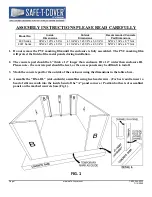
AM32 MULTIPLEXER
6
4.1 SINGLE LOOP INSTRUCTION SEQUENCE
(1 and 8) Activate/Deactivate AM32
- The
control port connected to reset (RES) is set high
to activate the AM32 prior to the measurement
sequence and set low following the
measurement loop(s). Instruction 86 with Port
commands (41-48 set high, 51-58 set low) is
used to set the port.
Instruction 20 is used to set the port in the pre
OS7 CR7 or pre OSX-0.1, 1.1, or 2.1 21X
dataloggers.
(2 and 6) Loop and End Loop
- A
programming loop is defined by Instruction 87
(Loop), and by Instruction 95 (End). Within
Instruction 87, the 2nd parameter (iteration
count) defines the number of times that the
instructions within a loop are executed before
the loop is exited. The iteration count is
typically equal to the number of sensors to be
read in the loop.
(3) Clock/Delay
- With a CR10(X) the clock line
is connected to a control port. Instruction 86
with the pulse port command (71 - 78), sets the
clock line high for 10 ms. Instruction 22 is used
to delay for an additional 10 ms.
When controlled by a 21X or CR7 datalogger,
the clock line may be connected to either an
excitation or a control port. Connection to an
excitation channel is preferred because only
one Instruction 22 is required to send the clock
pulse. Instruction 22 should be programmed to
provide a 10ms delay with a 5000mV excitation.
A control port can be used to clock the AM32 if
no excitation channels are available.
P22 Excitation with Delay
01:
2
EX Chan 2
02:
1
Delay w/EX (units=.01sec)
03:
1
Delay after EX (units=.01sec)
04: 5000
mV Excitation
The pre CR7 and 21X instruction sequence
required to clock with a control port is as
follows: Instruction 20 (set port high), then
instruction 22 (delay of 20 ms without excitation)
followed by instruction 20 (set port low).
(4) Measure -
Enter the instruction needed to
measure the sensor(s). Only one repetition is
entered for the measurement instruction.
The Input Location in which to store the
measurement is Indexed so that it is
incremented by one with each pass through the
loop.
INDEXING
An Input Location entered in an instruction that
is in a loop may be Indexed by keying "C",
before keying "A" to enter the Input location; two
dashes (--) will appear at the right of the display.
This causes the Location to be incremented
with each pass through the loop. The loop
counter is added to the indexed value to
determine the actual Input Location the
instruction acts on.
NOTE:
If more than 28 input locations are
utilized, then additional input locations must
be assigned using the datalogger *A mode.
Consult your datalogger manual for details.
(5) Optional Processing
- Additional
processing is sometimes required to convert the
reading to desired units. If it is important to
make all the measurements as close to one
point in time as possible, the optional
processing should be done in a separate loop.
Indexing of input locations may be required
during optional processing. The first program
example demonstrates this technique.
(7) Additional Loops
- Additional loops may be
used if sensors that require different
measurement instructions are connected to the
same multiplexer. In this instance, sensors that
are measured by the same instruction should
be grouped in sequential input channels. Each
group of sensors is measured in a separate
loop (steps 2 through 6, Figure 4-1). Each loop
contains clock and measurement instructions.
All loops must reside between the instructions
that activate and deactivate the AM32 (Steps 1
and 8).
4.2 MULTIPLE LOOP INSTRUCTION SEQUENCE
As shown in Table 5-1, the program to operate
the AM32 is essentially the same for all
Campbell Scientific dataloggers. To measure
sensors of different types, different
measurement instructions may be used within
successive program loops.
Summary of Contents for AM32
Page 27: ...This is a blank page ...











































